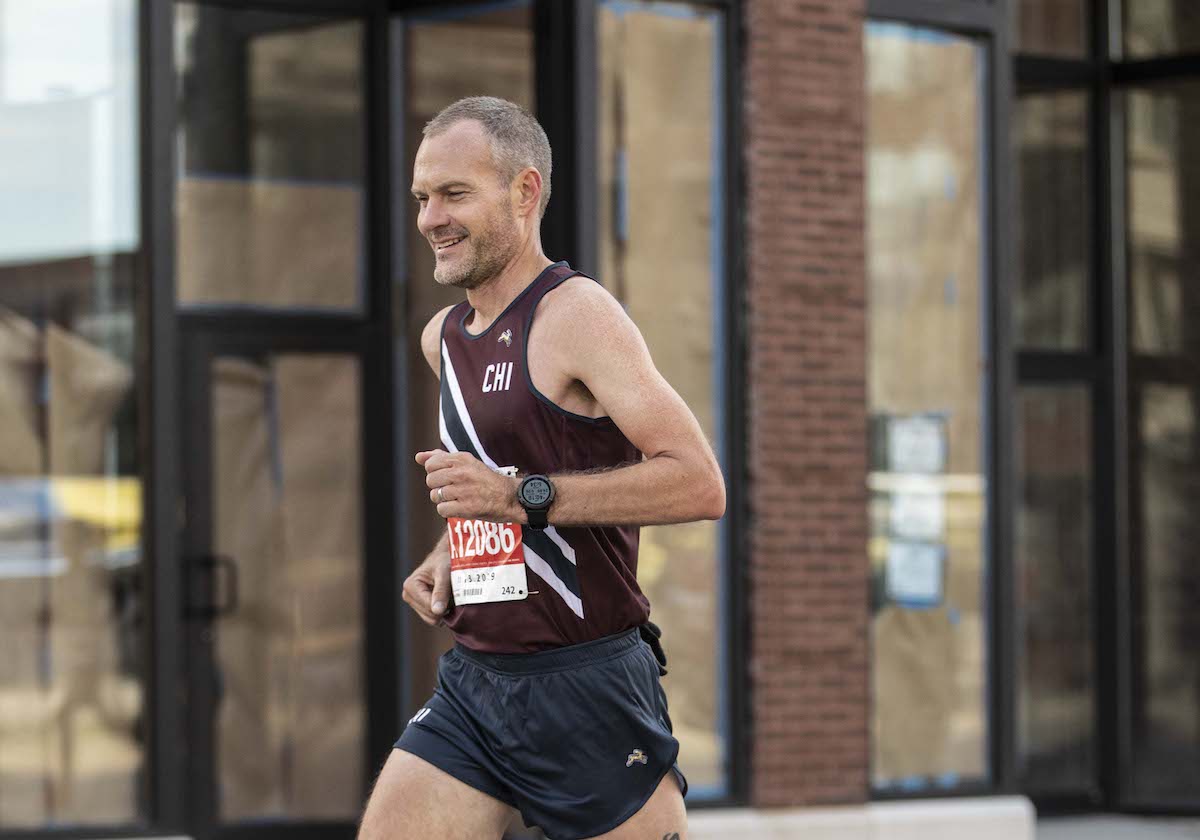
Don’t train like Jeff Dengate.
For a marathon, for a 10K, hell—even for a mile.
That is to say, don’t work out in the brick kiln of a New York City summer without drinking a drop of water. Don’t end a long run by going all-out in a little hometown race called the Fifth Avenue Mile. And for Chrissakes, on the night before your goal marathon, don’t put all your chips on black.
As in, the black, smoked crust of a brisket sandwich, washed down with a couple IPAs at a country-western bar in Chicago.
Or, do train like him.
Like you are indeed the Runner-in-Chief at Runner’s World, with an infinite amount of training advice at your disposal.
Do pencil in double workouts for almost every day that ends in ‘Y’. Do crank up the mileage into the nineties during the peak weeks of training. And lastly, during those painful miles of a marathon—make sure you smile like a circus clown because someone said ‘hey, you should do this thing’ the day before the race.
Do all of this, and maybe you’ll end up with a career day at the Chicago Marathon, smash a 10-year-old PR by nearly five minutes, and think—‘wow, after 34 years of running, I just might have this figured out.’
Before Jeff Dengate trained like himself, he was just a karate kid growing up in Clarkston, Michigan in the thick of the ’80s. And while he never crane-kicked his way to a state championship, his karate class would run a local 5K race every year, eventually translating into a love for running.
That passion became a dominant strand in the fabric of Dengate’s life, threading through high school and college (though he never ran competitively in college), and all through his 20s. Eventually, Dengate’s running career became exactly that— a career in running.
In 2007, he joined Runner’s World as a digital producer and later became the shoes and gear editor, left the company, then returned to his old shoe reviewer post. After leaving again, Runner’s World was bought by Hearst in early 2018. Dengate came on in his current role as the head of the publication, in charge of maintaining the direction of the brand.
Over the last year, Dengate, who is more inclined to “running up mountains, running in snowshoes, and doing crazy events,” found himself wondering if he could be fast. Not just in mile races and corporate 5K’s, but in an actual, straight-up marathon. Sure, fast is relative, but for him, that meant besting his PR of 2:54:33 set in 2010 at the Richmond Marathon.
“I’m really more of a mile/5K runner; those short strength events are more in my wheelhouse,” says Dengate, now 41. “The repetitive nature, living like a monk, of marathon training is tough. So I never really did it or put in the training I needed to.”
That’s not to say he’s never enjoyed them, to an extent. Along with his very-respectable time at Richmond, he’s also run the Boston Marathon every five years since 2010. Goal number one for this year was to qualify again—under 3:10 for his age bracket.
He accomplished that goal with minimal training, ramping up to the Vermont City Marathon in May, where he comfortably qualified for Boston with a 3:05:58. After a short dip in mileage the week after, the “A” goal was in effect. For the next 18 weeks, Dengate would train like he never had before.
The schedule was daunting. With Runner’s World offices in both New York City and Pennsylvania (and a family home in New Jersey), Dengate’s schedule leaves little room for marathon training. For the head of the largest running publication on the planet, the irony is cruel.
Blocking out runs into the daily Google calendar became a game of Tetris. Mornings began at 5 a.m. Midday runs doubled as both training and gear testing.
Nevertheless, Dengate was able to develop something resembling a plan, and he stuck to it. Unconventional may be a good descriptor, personalized may be a better one.
“I just ramped up the mileage, ate whatever I wanted, didn’t do speed work, didn’t do tempos. And then my fueling- we typically tell people to eat healthy, and like whatever, I don’t—I eat whatever I want,” says Dengate. “My wife and I do make healthy dinners, but I don’t ever limit myself, and I probably/definitely drink too much beer. A lot of nights I have potato chips for dinner. That’s just the reality of life.”
Runners eating and drinking too much isn’t exactly the revelation of the century. Chip dinners enter into questionable territory. Not to mention, that for Dengate, most runs were done in a fasted state. He typically didn’t eat between dinner the night before and lunch after his second workout of the day.
Yet the work of running was being done, and the foundation was being laid. His ramped-up mileage hovered in the 70-90 mile range, consisting of almost-daily doubles, and the standard long runs.
At one point, Dengate was out in Seattle for a meeting with Brooks Running. While the company offered a complimentary shuttle from his hotel to a morning meeting, Dengate turned down the offer and ran instead. (Side note: that’s how you show up to a meeting with a run company).
And yes, he ended a 19-mile long run at the starting line of the Fifth Avenue Mile. And yes, in true gear geek fashion, he changed into the ballerina racing slippers known as the New Balance 5280 before taking off.
“It hurt bad. It was stupid. I don’t recommend anyone do that,” says Dengate. (For what it’s worth, he ran a 5:11).
While Dengate tests nearly a hundred pairs of shoes a year, he laid the most miles down on pairs of the HOKA ONE ONE Rincon and the Reebok Floatride RunFast. Of course, like almost every damn runner with any aspirations these days, he also ran in the Nike Vaporfly NEXT% on race day.
The Chicago Marathon came fast enough, and while weather in the Windy City can be unpredictable at best (temperatures have swung from 30 to 90 degrees within the last decade), it was 41 degrees and blue skies at the start of the 2019 edition.
Dengate was no worse for wear from his dietary decisions the night before, and while his morning nutrition consisted of a lousy bagel, his fasted-state training had him ready.
In the hour leading up to the start, Dengate did, well—nothing.
“I didn’t even warm-up, just got in the corral, went from zero to 6:30 pace.”
And he was off.
The overall race plan went like this:
Even splits throughout. Alternate water and Gatorade every three miles. Fuel with Untapped Maple Syrup at miles 6 and 18, Maurten Gel at mile 12. Disregard the GPS watch, which will notoriously go bonkers within the first couple miles in downtown Chicago. Refer to the old-school pace wristband for split times. Run strong, run smart, finish sub-2:50.
“I just told myself to settle down, just get in a rhythm, see what happens, let the race come to you,” Dengate recalls.
As grueling as the marathon can be, as fickle as the body’s response, there was little drama on that day.
“Everything was fine, totally great, just rolling. Around mile 17 I felt awesome, then around mile 19, it sucked. I immediately shifted my mentality, looked down at my watch and knew I was 40 seconds quick, so I knew I could just give back 10 seconds,” remembers Dengate. “Relax, take a breather, and come out the other side.”
And that’s pretty much what happened, with a side of goofy mantra for good measure.
The day before, a friend of Dengate’s told him how marathon world record-holder Eliud Kipchoge’s strategy for hurting is to “smile through the pain.” (Indeed, some studies have shown a 2% efficiency increase when runners smile through activity.) Since runners will try anything in the aching stages of a marathon’s last 10K, Dengate went for it.
“Mantras aren’t my thing, I’ve just never had success, and all of a sudden this starts working and I’m like ‘ah man, what a fool I am,’” Dengate says, laughing. “So I smiled through the pain. Then I was right back on pace.”
The last mile delivered a howling headwind, pushing Dengate’s pace down to his slowest mile of the day; however, his cushion was secure. He came in at a near-perfect 2:49:37, almost five minutes faster than his PR from 10 years prior.

Photo courtesy of Nike
Like a lot of runners that day, Dengate crossed the finish line in a popping pair of pink Vaporfly NEXT%. And while his legs felt relatively fresh under the circumstances, he won’t give all that PR credit to a pair of premium race shoes.
“How much did the shoes help?” asks Dengate. “Everybody I talked to had PR’s or were pretty close. A runner I talked to who was 50, he was 13 seconds short of his PR and he was wearing a raggedy old pair of ASICS. It was a special day on that course in Chicago.
“Shoes were meant to go fast. My last marathon PR, I ran in the Saucony Kinvara 1, and I had switched from the New Balance 1400 the year before, so I went with the Kinvara cause that thing was fire back then. It was light and soft, and I ran faster. So now I have a shoe that’s lighter and softer and doesn’t penalize you for heel striking and isn’t mushy when you toe off. I’m not gonna lie, [the Vaporfly] is a fast shoe. But I don’t believe that it so much gives you speed, as it saves your legs later in the race to hold that speed longer.”
Whether the shoes gave a 4% efficiency boost or no-percent, the fact remains that Dengate trained like he never had before. And as unconventional as it was, it’s nothing new, as he’s quick to point out.
“Before we really started modern training plans, the old school runners were all high-mileage guys,” notes Dengate. “And low, slow, distance got a bad rap, but guys who were doing no formal workouts at all were doing 2:20 marathons.
“I honestly think the only reason I PR-ed, all things considered, is that I really ran a ton of miles. There’s no substitute for mileage, especially when it comes to the marathon.”
Whether it was the high mileage weeks, the double workouts, the diet (or lack thereof), or a combination of everything, it led to an exhilarating day. For Dengate, it was the kind of day he believes every runner should shoot for at some point.
“That sensation of being fast is exhilarating, regardless of what the time on the clock really is,” Dengate says. “Everybody should take a swing at it every once in a while and just remind themselves that it’s pretty damn cool to run fast.”
In that pursuit, just remember this:
“Don’t do what Jeff Dengate does, because I’ve been running for more than 30 years and found out what works for me and what I can get away with,” cautions Dengate. “It’s gonna end really badly for a lot of people who try it.”
Maybe, but you won’t know if you don’t try.
So go ahead and follow the Dengate method, and good luck to you—whether you end up with a new-found hatred for running, or you cross the finish line faster than you ever thought possible.
Just remember to smile.
Have something to say? Leave a Comment


And this article comes from RW? Not surprised.
Conclusion: No substitution for training (properly) and it’s the feet that run, not shoes.
Not sure why you thought it came from Runner’s World since we’re a competitor of theirs, but okay. Either way, thanks for reading, Jesus!
No, it doesn’t come from Runner’s World. It comes from Robbe Reddinger, who works for Big Run Media and Believe In the Run.
My college coach first told me to smile while racing back in 1985. Not sure what took Jeff so long to learn it.
Maybe he blocked it out cause it seems so ridiculous. But it works!
Yeah. Don’t do anything like Dengate, because he’s turned a once-decent magazine into the same kind of bullying-and-misogyny-comments shithole that the rest of the internet is. There’s no moderation, anyone can comes along and spew filth at women and people of color in RW comments, where people turn to bullying each other if they have no other target. It’s horrible and I can’t think of anything less like the RW people whose company I used to enjoy. It’s a real shame. Running needs less macho assholery, not more.